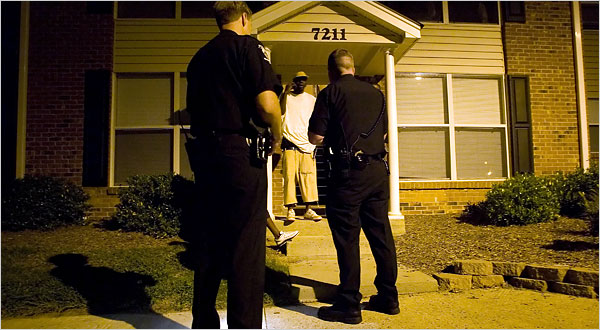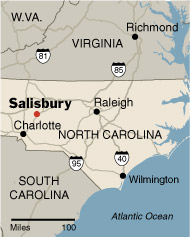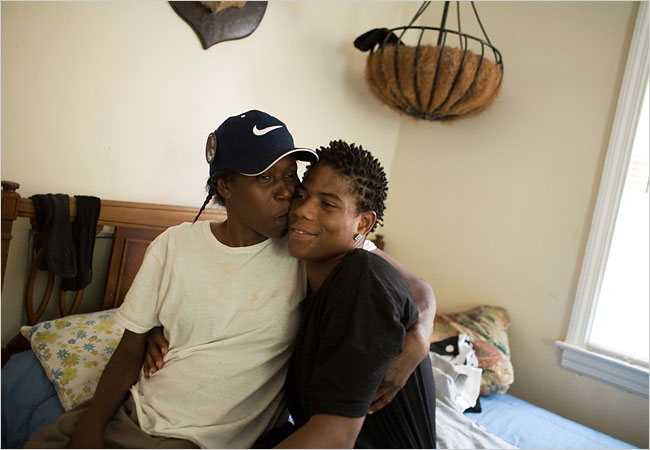| Want to send this page or a link to a friend? Click on mail at the top of this window. |
More Special Reports |
| Posted September 13, 2007 |
| Gangs Grow, but Hard-Line Approach Is Stirring Doubts |
 |
|
Chris Keane for The New York Times |
|
| Police officers in Charlotte, N.C., above, questioning residents in an apartment complex where gang mebers are thought to live. |
____________ |
|
By SOLOMON MOORE |
SALISBURY, N.C. — The party ended when a group of teenage boys shouted the name of their gang over the sound system: “Westside!” Across the dance floor another clutch of youths responded in kind: “Eastside!”
As more than 200 partygoers emptied into the parking lot that March night, an argument between the two gangs devolved into a shoot-out. The police arrived to find the crumpled body of a 13-year-old girl, Treasure Feamster, an innocent bystander.
The killing here, 35 miles from Charlotte, has helped rally support in North Carolina for a Los Angeles-style crackdown on gangs.
At least 36 states have passed hard-line laws similar to those pioneered in the 1990s by Los Angeles, and enacted statewide in California. The laws prohibit public gatherings of two or more people suspected of being gang members; establish databases to track gang members; deploy broad sweeps of suspects; and lengthen prison sentences for gang-related crimes.
But even as lawmakers in Raleigh have worked to create a similar gang law, doubts have been raised across the country about the value of the approach.
A growing number of law enforcement officials, including some in Los Angeles, suggest that such aggressive suppression tactics may worsen some gang problems by alienating whole groups of people from the police and stocking prisons with thousands of young people, many of whom are transformed into hardened gang members while incarcerated.
“L.A. has this approach of being tough on crime,” said Craig Watkins, the district attorney in Dallas, where some Los Angeles-style tactics are being rolled back. “But the result of that is overflowing prisons, high crime rates and increasing numbers of gang members. Now we want to be smart on crime.”
Large-scale arrests have been a key component of Los Angeles’s antigang approach for more than 30 years, said Constance L. Rice, director of the Advancement Project, a liberal group founded by civil rights lawyers that focuses on racial justice issues. Over the last decade, the authorities throughout Los Angeles County have arrested more than 450,000 juveniles, Ms. Rice said, while gang membership doubled.
Earl C. Paysinger, an assistant police chief and operations director for the Los Angeles Police Department, said the department’s “assertive gang suppression” was appropriate for gang members “whose sole purpose is to wreak havoc on the community.”
But Chief Paysinger said the department had not been discriminating enough in dealing with people suspected of being gang members who pose a lesser threat. He said a new mindset was beginning to take hold among the department’s leadership.
He said the police in Los Angeles were now focusing more on prevention and intervention before making arrests. Officers conduct more visits to the homes of possible gang members to encourage parents to become involved, Chief Paysinger said, and the department has made it easier for youngsters to purge their names from a gang database if they stay out of trouble.
“During my career I’ve probably arrested tens of thousands of gang members,” he said. “That doesn’t work. And now we’re doing what we can to, as my son says, flip the script.”
In Dallas, Mr. Watkins has instructed prosecutors to be increasingly selective when seeking prison sentences against young gang members who may benefit from rehabilitation programs. In June, the Texas Legislature approved $273 million for new prisons, but also $203 million for drug treatment and rehabilitation programs.
“In Texas, we tried to lock gang members up and not worry about them anymore,” Mr. Watkins said. “Now we want to lock them up, but we want to fix them.”
In Boston, Police Commissioner Edward F. Davis said his department had narrowed its focus to violent offenders.
 |
The New York Times |
| A killing in March raised anti-gang sentiment in Salisbury. |
“We clearly don’t participate in a wide net of arrests,” Mr. Davis said. “What we’re trying to do is to be very focused on those individuals who are actually shooting.”
But the tough approach still has great appeal in many states, especially those where serious gang problems are relatively new. State lawmakers here in North Carolina are working on legislation that would define a gang as any group of three or more people who band together for the “primary purpose” of committing a crime.
An early version of the bill included a provision that would have focused on gang members as young as 12. That part of the bill was eventually dropped, but it was an indication of the strong interest in a strict law-and-order stance.
This is organized crime, and just like we had specific laws to target organized crime in trying to break up the mafia, we need laws to break up the gangs,” said Patrick L. McCrory, the mayor of Charlotte. “It’s more than just selling drugs and participating in violence. These are coordinated and strategic acts within a structure, and you have to go after that structure.”
But some critics in North Carolina worry that the proposed law would worsen racial profiling in a state where African-Americans are less than a quarter of the population but account for nearly 60 percent of state prison inmates.
“It’s so broad that it’s going to catch a lot of young men of color who have nothing to do with gangs,” said the Rev. Landon J. Adams, director of the Triangle Lost Generation Task Force, a group in Raleigh that works to keep youths out of gangs.
In Charlotte, the state’s most populous and violent city, the police already take a hard-line approach to gang crime, and there have been complaints of racial profiling.
The Charlotte police staged an Independence Day sweep, arresting 26 juveniles and 143 adults. Of the adults, 122 were African-American. Civil rights advocates and African-American activists clamored for an apology the next day, insisting the roundup had been racially motivated and had snared innocent bystanders.
Instead, Mayor McCrory, who is white, issued a public letter that thanked the police for their “assertive law enforcement” and mused about young black people he saw during Fourth of July festivities.
“One disturbing trend which was strengthened last night while observing the thousands of youth in Center City is the following,” Mr. McCrory wrote. “Too many of our youth, primarily African-American, are imitating and/or participating in a gangster type of dress, attitude, behavior and action.”
A spokeswoman for the Charlotte police, Julie Hill, said that all of those arrested on July 4 had been charged with crimes, including juvenile curfew violations, disorderly conduct, marijuana possession and gun violations. A police report said that several of those arrested had been seen making gang gestures.
In a recent interview, Mr. McCrory, a Republican, said that young black men not affiliated with gangs could easily be mistaken for gang members.
“If they act and dress like a gang member, most people will assume they are a gang member, and that’s not beneficial for anyone,” he said. “This ganglike culture is tough to separate out — whether that’s fair or not, that’s the truth.”
After the death of Treasure Feamster here in Salisbury, the police chief, Mark Wilhelm, warned several hundred town hall participants that his police force would be “tougher on the young people” to fight gang violence.
Politicians and the police often mention high-profile gang violence like the killing to underscore the need for stronger gang laws. A more typical face of gang crime, statewide crime statistics show, is someone like Harvey Holden, 16, of Raleigh.
Mr. Holden, 16, was kicked out of two schools, once for possession of a knife at local public school and the second time for being high on marijuana at an alternative state school for delinquents. School officials said that he had been affiliated with gangs all along, but Mr. Holden said he joined six months after his second expulsion and attempted an unarmed robbery with several other young men.
 |
Jeremy M. Lange for The New York Times |
| Harvey Holden, with his mother, Lilly, says he joined a gang after his second expulsion from school. He now has a youth counselor. |
“We put scarves on our faces and ran up on two white guys when they were getting into their truck,” Mr. Holden said in an interview.
The would-be victims routed the youths, slammed Mr. Holden to the sidewalk, and held him until the police arrived. After serving several days in juvenile detention, Mr. Holden was placed on probation and assigned to a youth counselor, DeShannon Morris.
“The system is not set up to support these kids,” Mr. Morris said. “They just don’t care. There’s no human touch to it. They just want to lock everybody up.”
Copyright 2007 The New York Times Company. Reprinted from The New York Times of Thursday, September 13, 2007.
| Wehaitians.com, the scholarly journal of democracy and human rights |
| More from wehaitians.com |